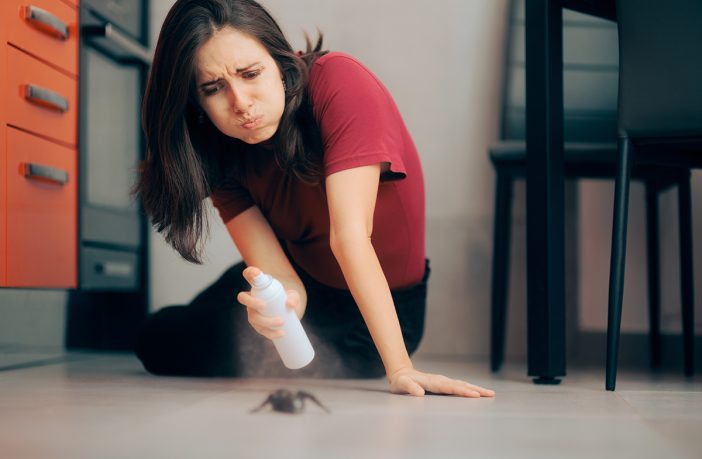Meteorologists across the board are warning of extreme weather in the summer of 2024 across most of the continental USA. While natural events such as heatwaves, storms, floods, and tornadoes are some of the more devastating impacts of extreme weather, an often-overlooked consequence is the increase in bug activity. Although bugs generally don’t cause the same devastating impacts as extreme weather events, they can become a severe annoyance, and getting rid of them can become quite costly for homeowners.
The Pest Dude recently analyzed predicted summer 2024 temperatures and rainfall data from Climate.gov across each U.S. state to determine which pests are more likely to be a problem in each state.
New York is predicted to have a much warmer summer than average with equal rainfall. This combination is likely to lead to an increase in activity of the following pests in the state: cockroaches, ants, spiders, houseflies, bed bugs, centipedes, crickets, silverfish, stink bugs, ticks, aphids, mites and gnats.
Zachary Smith of The Pest Dude breaks down why each of these bugs is likely to be more frequent in New York in summer 2024, and how they can best be treated:
Ants:
- Why More Frequent: Warm weather increases ant foraging activity, and rain can drive them indoors seeking shelter
- Treatment:
- Ant Baits and Traps: Place ant baits near entry points and along ant trails to attract and kill ants. Use bait stations that allow ants to carry the poison back to the colony.
- Seal Entry Points: Inspect and seal cracks and gaps around windows, doors, and foundations to prevent ants from entering the home.
- Maintain Clean Surfaces: Keep kitchen counters, floors, and food storage areas clean and free of crumbs, spills, and food residues that attract ants.
Aphids:
- Why More Frequent: Warm and humid conditions promote rapid aphid reproduction on plants.
- Treatment:
- Insecticidal Soaps or Oils: Apply insecticidal soaps or horticultural oils to plants to kill aphids without harming beneficial insects.
- Natural Predators: Introduce natural predators, such as ladybugs and lacewings, to control aphid populations.
- Regular Monitoring: Inspect plants regularly for signs of aphids and take early action to prevent infestations from spreading.
Ticks:
- Why More Frequent: Warm and humid conditions increase tick activity and host-seeking behavior.
- Treatment:
- Tick Repellents: Apply tick repellents to clothing and exposed skin before going outdoors. Wear long sleeves, pants, and tuck pants into socks when in tick-prone areas.
- Trim Vegetation: Keep grass, shrubs, and vegetation trimmed around the home to reduce tick habitats.
- Regular Tick Checks: Perform thorough tick checks on yourself, family members, and pets after spending time outdoors. Remove ticks promptly using fine-tipped tweezers.
- Yards: Should be treated with labelled insecticides. Also install fencing to prevent tick carrying wildlife from passing through.
Gnats:
- Why More Frequent: High humidity and standing water create ideal breeding environments for gnats.
- Treatment:
- Gnat Traps: Use vinegar or wine traps to attract and capture gnats. Place traps near windows, plants, and other gnat-prone areas.
- Reduce Moisture: Address moisture issues by fixing leaky pipes, ensuring proper drainage, and using dehumidifiers to reduce indoor humidity levels.
- Proper Drainage: Ensure outdoor areas have proper drainage to prevent standing water, which serves as breeding grounds for gnats.
Cockroaches:
- Why More Frequent: Warm temperatures and high humidity drive cockroaches indoors seeking food and shelter.
- Treatment:
- Cockroach Baits and Traps: Place baits and traps in areas where cockroaches are likely to travel, such as kitchens, bathrooms, and basements.
- Seal Entry Points: Inspect and seal cracks, gaps, and openings around doors, windows, and pipes to prevent cockroaches from entering the home.
- Clean and Dry Environment: Maintain a clean environment by regularly cleaning kitchen surfaces, disposing of garbage, and addressing any moisture issues.
Centipedes:
- Why More Frequent: Moist, warm environments encourage centipede activity.
- Treatment:
- Reduce Moisture: Use dehumidifiers and fix leaks to lower humidity levels.
- Remove Clutter: Eliminate clutter and debris that provide hiding places.
- Seal Entry Points: Seal gaps and cracks around the home to prevent entry.
Spiders:
- Why More Frequent: Warm temperatures increase spider activity and reproduction.
- Treatment:
- Reduce Clutter: Remove clutter and debris where spiders can hide.
- Seal Entry Points: Seal gaps and cracks around the home to prevent spiders from entering.
- Spider Traps: Use sticky traps to capture and monitor spider activity.
Houseflies:
- Why More Frequent: Warm weather speeds up the breeding cycle of houseflies.
- Treatment:
- Fly Traps: Use sticky traps or UV light traps to capture flies.
- Maintain Cleanliness: Regularly clean surfaces, dispose of garbage, and avoid leaving food out.
- Proper Food Storage: Store food in sealed containers to prevent attracting flies.
Bed Bugs:
- Why More Frequent: Increased travel and warmer weather contribute to bed bug infestations.
- Treatment:
- Regular Inspections: Inspect mattresses, bed frames, and furniture for signs of bed bugs.
- Heat Treatments: Use heat treatments or steam cleaning to kill bed bugs and their eggs.
- Professional Extermination: Hire a pest control professional for thorough bed bug treatments.
Crickets:
- Why More Frequent: Warm weather increases cricket activity and breeding.
- Treatment:
- Reduce Moisture: Fix leaks and reduce humidity levels to make environments less attractive to crickets.
- Seal Entry Points: Seal gaps and cracks to prevent crickets from entering the home.
- Cricket Baits: Use baits and traps to capture and reduce cricket populations.
Silverfish:
- Why More Frequent: Humid, warm conditions promote silverfish activity.
- Treatment:
- Reduce Humidity: Use dehumidifiers and fix leaks to lower moisture levels.
- Seal Entry Points: Seal gaps and cracks around the home to prevent silverfish from entering.
- Silverfish Traps: Use sticky traps or baited traps to capture and monitor silverfish activity.
Stink Bugs:
- Why More Frequent: Warm weather increases stink bug activity as they seek food and shelter.
- Treatment:
- Seal Entry Points: Inspect and seal gaps around windows, doors, and foundations.
- Vacuuming: Use a vacuum to remove stink bugs found indoors.
- Insecticides: Apply insecticides labeled for stink bugs around entry points and infested areas.
Mites:
- Why More Frequent: Warm, humid conditions favor mite reproduction on plants and in homes.
- Treatment:
- Insecticidal Soaps: Use insecticidal soaps or miticides to control mites on plants.
- Reduce Humidity: Use dehumidifiers and ensure proper ventilation to lower indoor humidity levels.
- Regular Cleaning: Clean and vacuum regularly to remove mites from carpets, furniture, and bedding.
“By understanding the reasons behind the increased activity of these pests and implementing effective treatment strategies, homeowners in Alabama can better protect their homes and enjoy a more comfortable summer”, says Mr Smith.











